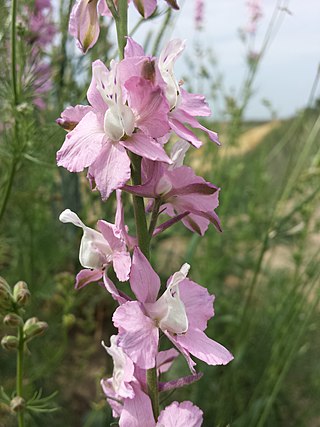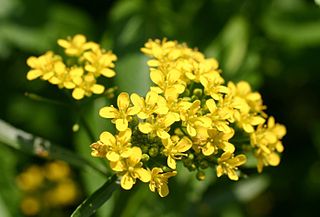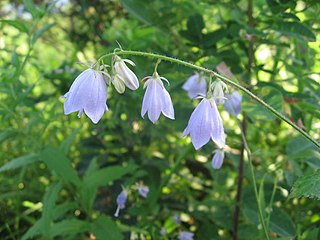
The Lamiaceae or Labiatae are a family of flowering plants commonly known as the mint, deadnettle or sage family. Many of the plants are aromatic in all parts and include widely used culinary herbs like basil, mint, rosemary, sage, savory, marjoram, oregano, hyssop, thyme, lavender, and perilla, as well as other medicinal herbs such as catnip, salvia, bee balm, wild dagga, and oriental motherwort. Some species are shrubs, trees, or, rarely, vines. Many members of the family are widely cultivated, not only for their aromatic qualities, but also their ease of cultivation, since they are readily propagated by stem cuttings. Besides those grown for their edible leaves, some are grown for decorative foliage. Others are grown for seed, such as Salvia hispanica (chia), or for their edible tubers, such as Plectranthus edulis, Plectranthus esculentus, Plectranthus rotundifolius, and Stachys affinis. Many are also grown ornamentally, notably coleus, Plectranthus, and many Salvia species and hybrids.

Consolida is a genus of about 40 species of annual flowering plants in the family Ranunculaceae, native to western Europe, the Mediterranean and Asia. Phylogenetic studies show that Consolida is actually an annual clade nested within the genus Delphinium and it has been treated as a synonym of Delphinium in Kew's Plants of the World Online.

Virgilia is a genus of Southern African trees in the family Fabaceae that is known for its very fast growth and a tendency to fall over as it matures. The common name in South Africa is keurboom, meaning 'choice tree'. Valued as useful ornamental trees by gardeners, the genus's two species are also known as tree-in-a-hurry, cape lilac, blossom tree and pink blossom tree.

Rorippa is a genus of flowering plants in the family Brassicaceae, native to Europe through central Asia, Africa, and North America. Rorippa species are annual to perennial herbs, usually with yellow flowers and a peppery flavour. They are known commonly as yellowcresses.

Tabernaemontana is a genus of flowering plants in the family Apocynaceae. It has a pan-tropical distribution, found in Asia, Africa, Australia, North America, South America, and a wide assortment of oceanic islands. These plants are evergreen shrubs and small trees growing to 1–15 m tall. The leaves are opposite, 3–25 cm long, with milky sap; hence it is one of the diverse plant genera commonly called "milkwood". The flowers are fragrant, white, 1–5 cm in diameter.

Vallaris is a genus of plants in the family Apocynaceae first described as a genus in 1768. It is native to China, the Indian Subcontinent, and Southeast Asia.
- Vallaris anceps = Kibatalia macrophylla
- Vallaris angustifolia = Kibatalia gitingensis
- Vallaris arborea = Kibatalia macrophylla
- Vallaris clavata = Echites clavatus
- Vallaris daronensis = Kibatalia maingayi
- Vallaris divaricata = Strophanthus divaricatus
- Vallaris fimbriata = Euphorbia mammillaris
- Vallaris gitingensis = Kibatalia gitingensis
- Vallaris ipecacuanhae = Euphorbia ipecacuanhae
- Vallaris lancifolia = Vallariopsis lancifolia
- Vallaris laxiflora = Pottsia laxiflora
- Vallaris macrantha = Beaumontia macrantha
- Vallaris maingayi = Kibatalia maingayi
- Vallaris missurica = Euphorbia missurica
- Vallaris portulacoides = Euphorbia portulacoides
- Vallaris × uniflora = Euphorbia × uniflora

Aristida is a very nearly cosmopolitan genus of plants in the grass family. Aristida is distinguished by having three awns (bristles) on each lemma of each floret. The genus includes about 300 species found worldwide, often in arid warm regions. This genus is among those colloquially called three-awnswiregrasses, speargrasses and needlegrasses. The name Aristida is derived from the Latin "arista", meaning "awn".

Caryopteris is a genus of flowering plants in the family Lamiaceae. They are native to east Asia.

Astilbe chinensis, commonly known as false goat's beard, tall false-buck's-beard or Chinese astilbe, is a plant in the saxifrage family, Saxifragaceae. It is a perennial herb that grows near shaded streams and rivers. It is also commonly grown in shade gardens.

Ajugoideae is subfamily of the family Lamiaceae. The subfamily name of Teucrioideae is a synonym of Ajugoideae.
Thespis is a genus of Asian plants in the tribe Astereae within the family Asteraceae.

Epaltes is a genus of flowering plants in the daisy family. They are distributed in Australia, the Americas, Asia, and Africa.

Periploca is a genus of plants in the family Apocynaceae, first described for modern science by Linnaeus in 1753. It is native to Europe, Asia, and Africa.
- Periploca aphyllaDecne. - Middle East from Sinai to Pakistan
- Periploca calophylla(Wight) Falc. - S China, Nepal, Bhutan, Assam, E Himalayas, Vietnam
- Periploca chevalieriBrowicz - Cape Verde Islands
- Periploca chrysanthaD.S. Yao, X.D. Chen & J.W. Ren - Gansu Province in China
- Periploca floribundaTsiang - Yunnan, Vietnam
- Periploca forrestiiSchltr. - Guangxi, Guizhou, Qinghai, Sichuan, Tibet, Yunnan, India, Kashmir, Myanmar, Nepal
- Periploca graecaL. - Mediterranean
- Periploca hydaspidisFalc. - Kashmir
- Periploca laevigataAiton - Canary Islands, Savage Islands
- Periploca linearifoliaQuart.-Dill. & A. Rich - Ethiopia
- Periploca nigrescensAfzel. - W Africa
- Periploca refractifoliaGilli - Tanzania
- Periploca sepiumBunge - widespread across much of China
- Periploca tsiangiiD. Fang & H.Z. Ling - Guangxi Province in China
- Periploca visciformis(Vatke) K. Schum. - Somalia

Tabernaemontana divaricata, commonly called pinwheel flower, crape jasmine, East India rosebay, and Nero's crown, is an evergreen shrub or small tree native to South Asia, Southeast Asia and China. In zones where it is not hardy it is grown as a house/glasshouse plant for its attractive flowers and foliage. The stem exudes a milky latex when broken, whence the name milk flower.

Diastella is a genus containing seven species of flowering plants, commonly known as “silkypuffs”, in the protea family. The name comes from the Greek diastellein “to separate”, with reference to the free perianth lobes – the plants are distinguished from the closely related and similar leucospermums by the possession of four free perianth segments. The genus is endemic to the Cape Floristic Region of South Africa where it has a very limited range and is associated with fynbos habitats. The species are all small shrubs. Most species are threatened.
Schnabelia is a genus of plants in the family Lamiaceae, first described in 1921. The entire genus is endemic to China.
Pseudocaryopteris is a genus of plants first described in 1999. It is native to China, Thailand, Myanmar, and the Himalayas.
Saposhnikovia is a monotypic genus of flowering plants in the family Apiaceae. Its only species is Saposhnikovia divaricata, known as fángfēng防風 in Chinese, bangpung in Korean, and siler in English. The plant is still frequently referenced under the obsolete genus name Ledebouriella in many online sources devoted to traditional Chinese medicine. It was first described as Stenocoelium divaricatum by Nikolai Turczaninow in 1844, and transferred to Saposhnikovia in 1951.
Agalinis divaricata is a flowering plant species in the genus Agalinis. It is commonly known as pineland false foxglove. A dicot, it grows in parts of Florida, Georgia and Alabama. It is in the Orobanchaceae (broomrape) family. It grows in dry longleaf pine forests and savannahs. The genus is hemiparasitic.

Adenophora divaricata, also known as spreading-branch ladybell, is a flowering perennial plant of the genus Adenophora, in the Bellflower family. It is distributed in East Asia, including China, Japan, Korea, and the Russian Far East.















